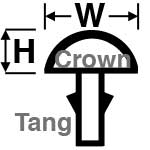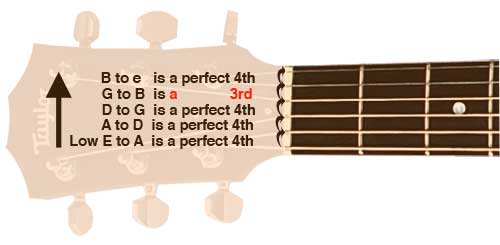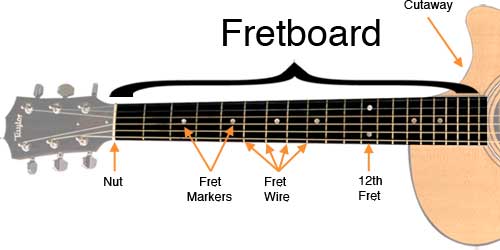Guitar Fretboard Guide
Every beginner needs to become familiar with the guitar fretboard. Knowing about the layout, string names, note names, intervals, and other characteristics prepares you for growth.
By the way, some people refer to the fretboard as the fingerboard. Either term works. I tend to use fretboard on this site.
Here are a few ways you'll benefit by understanding your guitar fretboard:
- TAB will make sense!
- You can find the notes when you read music notation.
- You'll understand where to move your hands to play barre chords.
- You are prepared to move scales up and down the neck.
- Riffs and improvisation open up for you.
- You can more easily communicate with other musicians.
- More...
Let's get started.
What's a Fret?
The fretboard (or fingerboard) is divided into a number of segments, called frets. Each fret is carefully placed to allow you to create a specific pitch. The difference in pitch from one fret to the next is one semi-tone (or one half step).
Notes of The Guitar Fretboard
Each note is based on a mathematic formula. The formula defines the length of string needed to produce a specific pitch. When you depress the string at a particular fret, it's the same as if you'd cut the string to that length. That's why it's important that you place your finger just behind the fret marker, and not apply too much pressure. If you put your finger in the wrong place, place too much pressure on the string, or bend the string out of position, you're changing the pitch. Soloists often do this on purpose. It's called "bending the note."
In a perfect world the correct pitch could be produced at each fret, on each string. In reality guitar designers work with a set of compromises that produce the closest set of pitches across all six strings at each fret location. If you've ever worked hard to tune your guitar, only to discover that a particular note or chord still sounds a little off, you've stumbled onto one of these compromises. Some guitars allow you to adjust the intonation (the slight problems in tuning up and down the fretboard). Sometimes you need to have an experienced guitar tech or luthier fix these problems (if they bother you).
To learn more about pitch, read the Basic Music Theory page.
How many frets are enough?
The number of frets varies from one guitar to another, but all should have at least twelve. Most electric and acoustic guitars have twenty-two frets, which is plenty.
Why "at least twelve"? With twelve frets you can produce one full octave on each string (an octave contains 12 distinct notes).
More frets means a wider range of notes on a given string. However, past a point additional frets become hard to play, and a very long fretboard would interfere with the acoustic guitar sound hole or electric guitar pickups.
Nearly all electric guitars, and many acoustic guitars, have a "cutaway" or "cutout" on the body. The cutaway (see the image below) is on the same side as the hand used to play notes and chords, near the fretboard. The cutaway allows the guitarist to reach upper frets without contorting their arm and wrist around the guitar body.
Guitar Fretboard Construction
The fretboard must be smooth and durable.
A smooth surface prevents damage to your fingertips as you constantly press down on the strings, allows smooth bends, and prevents undue damage to your strings.
The hard finish and tough woods used also prevent damage from the strings of the guitar as you play.
Most guitar fretboards are made of rosewood, maple, or ebony. Some experienced guitarists can hear the slightly different tones produced by these woods, but most beginners can't. As a beginner, you're better off choosing the fretboard wood for it's look, if that's what will motivate you to play more often.
 Fret wire must also withstand lots of use, so either steel or a nickel/silver composite are frequently used.
Fret wire must also withstand lots of use, so either steel or a nickel/silver composite are frequently used.
Fret wire is not round, though it appears to be when you look at your guitar. It is actually shaped like a mushroom. The portion similar to the cap of a mushroom, which you can see, is called the crown. The equivalent of the stem of a mushroom is called the tang. There are slight barbs on the sides of the tang to help hold the fret wire in place. Fret wires are also held in place with glue, and sometimes with lacquer on the fretboard.
The crown, or cap, of a fret wire is available in several different widths and heights. Some players prefer fret wire that is wider, taller, lower, or thinner than others. If you ever need to take your guitar to a tech or luthier to fix intonation problems, they may "trim the frets". This means that they carefully sand down one side or another. The altered shape is frequently enough to correct even the most severe intonation problems. If you missed our explanation of intonation, see the section called 'Notes of The Guitar Fretboard', above.
Guitar Fretboard Layout
As you learn guitar, you'll hear references to fret positions, such as first-fret, third-fret, and so on. Frets are counted from 1, beginning at the space adjacent to the Nut. Fret markers are a visual reference point to find frets quickly. They are traditionally placed on the 3rd, 5th, 7th, 9th, and 12th frets. The twelfth fret usually has a double-dot marker. Fret markers then repeat, beginning at the 15th.
It does matter where and how you press your fingertips on the guitar strings. It's better to place your fingertip as close to the fret wire as possible (without putting your finger on top of the fret wire) and to use as little pressure as possible.
String Layout & Names
The strings are identified by number and by open pitch.
Strings are numbered from one to six, beginning with the thinnest string (the top string in the photo above). This may seem upside down to you when holding the guitar, because string six is the one closest to your head.
String names always refer to traditional open tuning, even if you tune differently. Beginning with string one (the thinnest string) the string names are e, B, G, D, A, E. The first string (sometimes called high-e) often uses a lower-case e to distinguish it from the sixth string, the low-E.
You can learn more about string layout and names on our Guitar String Names page.
An Important Oddity Of The Guitar Fretboard
The standard open tuning used for guitar makes it easy to play many chord forms, and with one exception, scale patterns.
The exception you need to remember is the B string. The tonal distance from every other string to it's neighbor is a perfect fourth. The tonal distance from the G string to the B string is a third, specifically a major third. This means that you need to adjust any pattern, such as scales, by one fret when you reach the B string.
The following diagram illustrates the point. Note that the diagram shows the intervals from string 6 to string 1. This is the typical way they are taught.
 |



